Positive Health Online
Your Country

Universal Application of Polarity Therapy The Application of Universal Principles of Energy and Healing
listed in polarity therapy, originally published in issue 67 - August 2001
In polarity therapy we recognize that energetic balance is the essential prerequisite for health and that the cause of any illness is to be sought in the disturbance of this balance. Polarity therapy is therefore totally energetic in its theory and practice, drawing on the universal principles of energy set out in the Ayurvedic (Indian) tradition of healing.
In this article we shall focus on these universal principles of energy and how they are applied in polarity therapy. The result is a remarkably simple approach to 'hands-on' healing, requiring great sensitivity of touch. The depth of touch, positioning of the hands and sequence of moves is dictated by the clues presented during a session by the body's self-healing process, so that no two treatments will be the same. The Ayurvedic principles of energy provide the conceptual foundation upon which such intuitive treatment is based. These principles are: Unity, Polarity, Three Forces, Five Elements.[1]
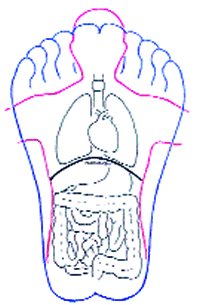
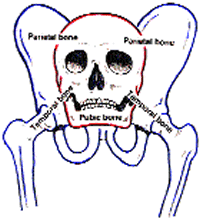
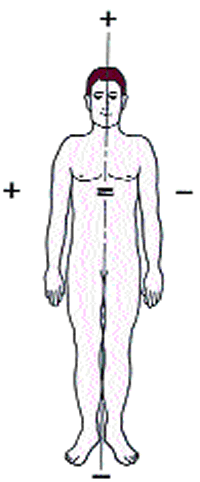
NOTE: The front of the body as a whole is negative, receiving stimuli via the senses. The back of the body is positive.
Unity
Everything in creation, from the most subtle vibration to the densest physical object, is a form of consciousness, where consciousness is taken to mean the Source from which everything in creation is derived. What consciousness is in itself is beyond description, beyond qualities. In the words of Thaddeus Golas:
"The universe is made of one kind of whatever-it-is, which cannot be defined. For our purpose, it isn't necessary to try and define it. All we need to do is to assume that there is only one kind of whatever-it-is, and see if it leads to a reasonable explanation of the world as we know it."[2]
Although consciousness cannot be defined, i.e. comprehended with the ordinary intellect, it can be known. It is what Castaneda called "the place of silent knowledge"[3],[4] – it is what everyone seeks, and is experienced in practice as the stillness contained within awareness. Stillness is the expression of unity within our experience.
The presence of this stillness is the precondition of healing and is the quality the polarity therapist aspires to bring to the therapeutic situation. During a session of polarity therapy, there are times when the therapist simply listens to the body with the hands in gentle contact, waiting until a sense of calm embraces both client and practitioner. Such calm reminds the client of a place they can always return to, whatever the physical, mental or emotional condition may be.
Polarity
When consciousness expresses itself in creation, it takes on qualities, e.g. hot, dry, cold, moist. Therefore, in the discussion of creation that follows, the word 'energy' will be used instead of 'consciousness', using energy in the sense of consciousness expressing itself in creation.
On the universal scale, creation can be viewed as an expansion of energy from the centre outwards to the periphery, followed by a contraction from the periphery to the centre, like an outward and inward breath. By periphery is meant the limit of creation, which contains all forms, from the most subtle to the most gross. As an analogy, the outward movement of creation may be viewed when a pebble is dropped into still water. Waves move outwards until the energy is dissipated. If the waves were to reflect back from their extremity to the centre where the pebble met the water, we would have a picture of the creative process. As pointed out by Randolph Stone, the founder of polarity therapy, the return to the centre is essential if energy is to be conserved.[5] The human condition is one in which we remain trapped at the periphery, in the creation, and do not return to the centre, the source of our Being, for replenishment. Polarity therapists are acutely aware of the overriding importance of this replenishment from Source if health is to be maintained.
The centre and the periphery constitute a relationship, or polarity, which exists as an idea in the creative mind prior to the movement of energy. Without this idea of relationship or polarity, expansion and contraction would not take place and energy would not flow. Thus, polarities are a precondition for the flow of energy. In polarity therapy there is a deep recognition of this universal principle, hence its name.
Practical Examples
To take a familiar example of polarity, we know that it is the existence of a relationship between two people that determines whether or not energy flows between them. Moreover, that nature of the relationship governs the quality of the flow of energy, whether compassionate or angry, courageous or fearful, etc.
In polarity therapy there are various ways in which the hands may be placed in two positions to establish a relationship. This relationship is chosen to relieve pain, clear sore reflexes, or to balance energy, as dictated by the client's condition. For example, a painful shoulder may often be relieved by polarity. A simple method is to explore the shoulder for sore places (reflex points). A finger of one hand is placed on one sore place, while the finger of the other hand is placed on another located on the opposite side of the shoulder. The practitioner waits until the soreness is discharged. Often, tissue changes may be detected under the fingers. When the soreness has completely gone, the hands are placed lightly above and below the shoulder to allow the body to integrate and balance the energy released from its 'stuck' condition in the shoulder. While this is taking place, the client often experiences heat from the practitioner's hands. This heat is drawn from the practitioner by the body's self-healing process to relieve any residual tightness in the shoulder. Sometimes, clearing a painful shoulder is aided by carefully moving the arm in its joint to mobilize the tissues. In polarity therapy, the painful shoulder may also be relieved by relating it to another part of the body e.g. navel or sitting bone. It is a question of discovering 'what works'.
The example of a painful shoulder illustrates the use of different degrees of touch: penetrating touch, as in holding sore reflex points, moving touch and light gentle touch for balancing. The use of these different kinds of touch is a particular feature of polarity therapy.
The polarity principle can be readily applied by reflexologists to enhance their treatment. As an example, tightness in the colon may be released by placing one hand over the affected part of the colon, while a finger of the other hand holds the appropriate reflex point on the hand or foot. Simply wait and feel for release. Alternatively, with knowledge of polarity contact points on the body, the reflexologist can simply hold two points on the foot and wait for release.[6]
The Three Forces
Whereas polarity or relationship is the precondition for the flow of energy, three forces govern the actual flow of energy. We may call these three forces positive, negative and neutral, familiar terms for the poles necessary for the flow of electricity. The qualities of the three forces as described in the Ayurvedic tradition are:
* Positive: Energetic, expansive;
* Negative: Receptive, nurturing, cohesive;
* Neutral: Subtle, balancing, harmonizing.
In polarity therapy, the three forces are applied in practice to provide simple guidelines as to where to place the hands on the body to free congestion and balance energy flow. This is discussed in the next section (The Five Elements).
The Five Elements
The energy that flows within the body is called 'chi' in the Chinese tradition, 'prana' in Ayurveda, and 'vital force' in the West. Although one indivisible energy, it manifests as five qualities, called elements: Ether (space); Air (movement); Fire (transformation, heat); Water (cohesion, fluid); and Earth (materiality, stability). In polarity therapy, these elements are used as a basis for diagnosis; for instance, poor digestion may indicate an imbalance in Fire, nervousness a problem with Air, obesity a disturbance of Water, and lack of 'grounding' a need to balance the Earth element. Where Ether (space) is a problem, the person feels overwhelmed by events: there is literally no space, nowhere to turn.
In diagnosis we have to bear in mind that the disturbance of one element may affect another; for example, the primary cause of poor digestion (Fire) is often nervousness (Air). In such a case it is the Air element that we would need to balance rather than Fire.
Polarity therapy describes where to place the hands on the body to balance each element by applying the principle of the three forces: Each element has a positive (+), neutral (=) and negative (-) position on the body; for example, for Earth these are neck (+), colon (=) and knees (-). Table 1 lists these positions for each element, and we can see that the colon comes under both Earth (materiality) and Air (movement). This means that the colon can be balanced by relating to either Earth (neck, knees) or Air (shoulder, shins): it is a question of discovering the most effective contact point for release. In general, any part of the body will have more than one place to which it may be related for release.
| Table 1: Positions on the Body for Each Element | |||
| Element | Positive | Negative | Neutral |
| Earth | Neck | Colon | Knees |
| Fire | Eyes | Solar Plexus | Thighs |
| Air | Shoulders | Kidneys, colon | Shins |
| Ether | There are no poles: Ether is located in joints | ||
Summary of Relationships Used in Polarity Therapy
1. Above and Below
Points located on each side of the body or body part form a relationship, as described for the shoulder earlier in this article. This may be called the 'above and below' technique and is often very effective; for example, treating headaches by placing one hand over the headache, and the other on the opposite side of the head. The practitioner simply waits for the energy to move.
2. Five Element Relationships
Relationships derived from the threefold expression of the five elements in the body, summarized in Table 1.
3. The Part Contains the Whole
Randolph Stone discovered valuable relationships for healing by applying the principle that the part contains the whole; for example, if the whole body is superimposed on the foot, hand or ear, the relationship between body parts and points on the foot, hand or ear becomes clear (see Figure 1). These relationships are familiar to reflexologists. The polarity therapist will contact the foot reflex with one hand and the actual body part with the other. For instance, an effective way to release the diaphragm is to touch the diaphragm line on the foot with the fingers of one hand, while the other hand makes contact with the diaphragm under the ribcage. The easing of the body tissues in unmistakeable.
In a similar manner, Randolph Stone derived relationships between the cranium and the pelvis (Table 2 and Figure 2). These relationships may be used to balance the central nervous system and encourage the flow of cerebro-spinal fluid (CSF). (Randolph Stone stressed the fundamental importance of CSF to health and described techniques for achieving optimal flow.)
| Table 2: Relationships Between the Cranium and the Pelvis | |
| Cranial Bone | Pelvis |
| Occiput | Sacrum |
| Sphenoid, ethmoid | Coccyx |
| Parietal | Ilium |
| Jaw joint (TMJ) | Hip joint |
| Jaw | Pubic bone |
4. Relationships Based on the Zone Chart
Randolph Stone applied the principle of Three Forces to the body as a whole, as shown in Figure 3. He then applied the principle that the part contains the whole to produce the zone chart (Figure 4). This provides a basis for selecting contact points: all positive, negative or neutral areas relate to each other; for example, a sore place on the middle of the thigh (positive) may be relieved by relating this to the middle of another positive area: chest, foot, toes, fingers.
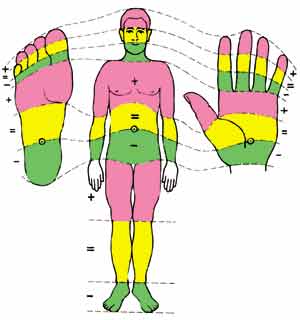
Figure 4: The Zone Chart
5. Spinal Relationships
There are some highly effective approaches to working with spinal problems available in polarity therapy. For example, following the principle of Three Forces, Randolph Stone found that vertebrae fall into groups of three, called 'spinal harmonics', as shown in Figure 5. In order to relieve congestion in one vertebra, contact is made with that vertebra and another in the triad. So, for instance, congestion in C3 can be relieved by contacting T5 or L3. After a while, any soreness or tightness will resolve and energy will be experienced passing between the hands. Often it is possible to sense the vertebra moving and realigning itself as the contact is maintained. The client may well experience relief of back pain and an improvement in the function of internal organs related to the vertebra.
The process of spontaneous movement of a vertebra is an example of the general phenomenon called 'unwinding'. Clients often experience such movement of a body part, e.g. an arm, during the maintenance of polarity contacts. 'Unwinding' often results in a dramatic reduction of pain in the affected part of the body.

Figure 5: Spinal Harmonics
6. Navel Contact
The fiery energy of the solar plexus may be harnessed to move congested Energy. For example, painful joints will often clear if navel contact is made with one hand, and contact with the joint with the other.
7. Contacts with the Ischium (Sitting Bone)
Many parts of the body may be released by being related to the ischium, e.g. joints, erector spinae muscles and pelvis. Working sore points in the erector spinae muscles with one hand whilst maintaining ischial contact with the other forms an important part of polarity work on the back. The sacro-iliac joint may be released with ease when related to the ischium, as is any other part of the pelvis.
8. Intuitive Contacts
Sometimes, the therapist has an intuitive sense of where to place the hands. Trusting such insights, which do not depend on diagnosis, can lead to excellent results.
The Polarity Session
In general, the polarity therapist will gain clues as to the way to proceed from case history details and observation of the body as to its posture, places of tension, quality of the auric field and presence of sore reflex points on the feet and body as a whole.
The session unfolds as the therapist uses appropriate contact points to clear sore reflexes and balance energy. The practitioner's choice of contact points is guided in part by client feedback of their ongoing experience. (This experience may include emotions, e.g. fear, released from the tissue memory for resolution with the support of the therapist.[7] Thus, the sequence of contacts evolves as a result of co-operation between client and practitioner. No two sessions are ever the same: each is an adventure leading the client towards physical ease, energetic balance and stillness.
Case History
Jane is in her 50s and presented with the following conditions:
* Two frozen shoulders – treated with cortisone injections;
* Painful knees – possibly due to osteo-arthritis;
* Numbness in hands and fingers;
* Terrible backache – said to be caused by a trapped nerve.
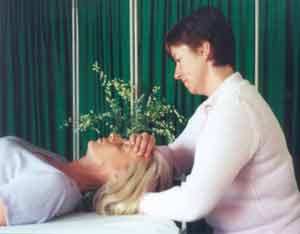
Headache treatment using 'above and below' technique
Osteopathic and chiropractic treatment had not helped, so Jane was resigned to taking painkillers for the rest of her life. Despite all this, Jane remained cheerful and bright.
Jane received six polarity treatments over a period of four weeks, each session lasting about an hour. A variety of polarity contacts were used according to what seemed appropriate on the particular occasion:
* Holding the head in both hands – the 'cradle hold' – and allowing the neck to 'unwind', that is to release itself spontaneously;
* Supporting the arm and allowing it to 'unwind' from the shoulder joint, at the same time maintaining polarity contacts on the shoulder and elbow to encourage energy flow;
* Connecting the joints in general and the knees in particular to the navel centre;
* Working up the spine whilst maintaining contact with the ischium;
* General pelvic release and connections between gluteal muscles and shoulders, to release tension in both contact areas.
After six sessions, Jane's shoulders and back were almost pain free and the knees flexible, with much reduced need to take painkillers. Her energy levels and sleep were much improved. Jane said that she felt ten years younger and that polarity had worked wonders with her body: "I only wish I had heard of this treatment earlier – fantastic!"
Jane realizes that there is still further to go and is enthusiastically receiving further treatment.
References
1. Sills F. The Polarity Process: Energy as a Healing Art. Element Books. Dorset. ISBN 1-85230-052-3. 1989.
2. Golas T. The Lazy Man's Guide to Enlightenment. Gibbs Smith. Layton. Utah. ISBN 0-87905-698-3. 1972 and 1995.
3. Castaneda C. The Power of Silence: Further Lessons of Don Juan. Black Swan. ISBN 0-552-99332-8. 1988.
4. Deavin A. Polarity Therapy: Part 2. Positive Health. May/June 1996.
5. Stone R. Polarity Therapy: The Complete Collected Works. CRCS Publications. Nevada. ISBN 0-916360-48-2. Vol. 1. p15. 1986.
6. Williamson J. An Introduction to Precision Reflexology. Positive Health. June 1998.
7. Deavin A. Releasing Trauma Through Bodywork: The Power of Awareness. Positive Health. August 2000.
Further Information
For details of training in polarity therapy conducted by Anthony Deavin, write to 11 The Orchard, Ashurst Drive, Tadworth, Surrey KT20 7LP, or Tel: 01737 842749.
The UK Polarity Therapy Association, Tel: 0700 7052748, and The Federation of Polarity Trainings, Tel: 01242 522352, will supply names of qualified polarity therapy practitioners and contact information for training in polarity therapy.
Acknowledgment
The author wishes to acknowledge the help and advice freely given by Helga Frank and Jo Scrimshaw during the preparation of this article.
Fig 1. was modified from Polarity Therapy by Alan Siegel. Prism Press. 2 South St. Bridport, Dorset DT6 3NQ ISBN: 0-907061-85-0. Figs 2, 3 and 4 were modified from Frankly Sills diagrams in The Polarity Process. Element Books. ISBN 1-85230-052-3.
Comments:
-
James Mitchell said..
I am a yoga teacher and interested in polarity therapy. Could you give me the name of a good book on polarity therapy.There are so many... and what to choose from?? If you could help here I would be very grateful. Yours sincerely James Mitchell. (from Scotland)